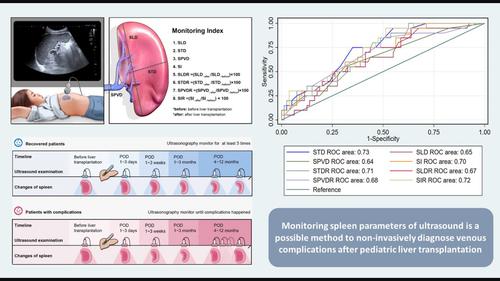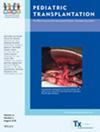预测小儿肝移植静脉并发症的新方法:通过超声波评估脾脏参数
IF 1.4
4区 医学
Q3 PEDIATRICS
引用次数: 0
摘要
背景小儿肝移植术后静脉并发症严重影响患者和移植物的存活率。目前,诊断指标尚未统一。静脉并发症可引起门静脉高压,从而导致脾脏肿大和脾静脉扩张。因此,脾脏的变化可能与静脉并发症密切相关。本研究的目的是探讨超声脾脏参数与静脉并发症的关系,并研究这些脾脏参数是否可用于静脉并发症的诊断。方法我们回顾性地纳入了接受肝移植的儿科患者,并收集了肝移植前、肝移植后1-3天、1-3周、1-3个月和4-12个月的超声脾脏参数。我们观察了肝移植后 1 年内是否有门静脉或肝静脉并发症。结果在我们的研究中,109 例肝移植后的小儿患者中有 11 例出现门静脉并发症,9 例出现肝静脉并发症。脾脏横径、脾脏纵径、脾脏门静脉直径、脾脏指数、脾脏横径比、脾脏纵径比、脾脏指数比是静脉并发症的独立危险因素。脾横径(AUROC:0.73)、脾指数(AUROC:0.70)、脾横径比(AUROC:0.71)和脾指数比(AUROC:0.72)预测静脉并发症的准确性高于其他参数。本文章由计算机程序翻译,如有差异,请以英文原文为准。

A new method to predict venous complications in pediatric liver transplantation: Evaluation of splenic parameters by ultrasonography
BackgroundVenous complications after pediatric liver transplantation seriously affect the survival rate of patients and grafts. At present, the diagnostic indicators have not been unified. Venous complications may cause portal hypertension, which may lead to splenomegaly and splenic vein dilatation. Therefore, the changes in spleen may be closely related to the venous complications. The purpose of this study was to explore the relationship between ultrasonic splenic parameters and venous complications and to study whether these splenic parameters can be used for the diagnosis of venous complications.MethodsWe retrospectively included pediatric patients who underwent liver transplantation and collected ultrasonic spleen parameters before, and then 1–3 days, 1–3 weeks, 1–3 months, and 4–12 months after liver transplantation. We observed whether there were portal vein or hepatic vein complications within 1 year after liver transplantation.ResultsAmong 109 pediatric patients after liver transplantation included in our study, 11 of them suffered from portal vein complications and nine hepatic vein complications. Spleen transverse diameter, spleen longitudinal diameter, spleen portal vein diameter, spleen index, spleen transverse diameter ratio, spleen longitudinal diameter ratio, and spleen index ratio were independent risk factors of venous complications. The accuracy of spleen transverse diameter (AUROC: 0.73), spleen index (AUROC: 0.70), spleen transverse diameter ratio (AUROC: 0.71), and spleen index ratio (AUROC: 0.72) in predicting venous complications were higher than other ones.ConclusionsUltrasonic examination is a common follow‐up method for pediatric patients after liver transplantation and the application of ultrasonic spleen parameters may be helpful to monitor venous complications.
求助全文
通过发布文献求助,成功后即可免费获取论文全文。
去求助
来源期刊

Pediatric Transplantation
医学-小儿科
CiteScore
2.90
自引率
15.40%
发文量
216
审稿时长
3-8 weeks
期刊介绍:
The aim of Pediatric Transplantation is to publish original articles of the highest quality on clinical experience and basic research in transplantation of tissues and solid organs in infants, children and adolescents. The journal seeks to disseminate the latest information widely to all individuals involved in kidney, liver, heart, lung, intestine and stem cell (bone-marrow) transplantation. In addition, the journal publishes focused reviews on topics relevant to pediatric transplantation as well as timely editorial comment on controversial issues.
 求助内容:
求助内容: 应助结果提醒方式:
应助结果提醒方式:


